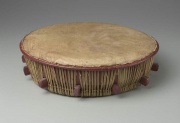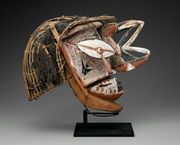Difference between revisions of "Rattan"
Jump to navigation
Jump to search
(username removed) |
|||
| (One intermediate revision by one other user not shown) | |||
| Line 1: | Line 1: | ||
| − | [[File:1981.779-SC24642.jpg|thumb|]] | + | [[File:1981.779-SC24642.jpg|thumb|Frame drum<br>1981.779]] |
== Description == | == Description == | ||
Any tall, slender stem from climbing palms of the genera ''Calamus, Plectomia, Desmoncus,'' or ''Daemonorops'' native to tropical Asia. Rattan stems are long, tough, flexible and durable. They are split lengthwise and woven shiny side up to make the backs and seats of chairs, umbrella handles, whips, baskets and baby carriage bodies. Rattan caning became popular about 1660 in England and was widely used during the Victorian period. Rattan has also been used for papermaking in the far East. | Any tall, slender stem from climbing palms of the genera ''Calamus, Plectomia, Desmoncus,'' or ''Daemonorops'' native to tropical Asia. Rattan stems are long, tough, flexible and durable. They are split lengthwise and woven shiny side up to make the backs and seats of chairs, umbrella handles, whips, baskets and baby carriage bodies. Rattan caning became popular about 1660 in England and was widely used during the Victorian period. Rattan has also been used for papermaking in the far East. | ||
| + | [[File:1991.1072-SC1606.jpg|thumb|Melanisian mask <br>MFA# 1991.1072]] | ||
== Synonyms and Related Terms == | == Synonyms and Related Terms == | ||
rottan; cane; caning; canework; ''Calamus; Plectomia; Desmoncus; Daemonorops; ratán (Esp.)'' | rottan; cane; caning; canework; ''Calamus; Plectomia; Desmoncus; Daemonorops; ratán (Esp.)'' | ||
| − | == | + | == Resources and Citations == |
| − | |||
| − | |||
| − | |||
| − | |||
| − | |||
| − | |||
| − | |||
* ''Fairchild's Dictionary of Textiles'', Phyllis G.Tortora, Robert S. Merkel (eds.), Fairchild Publications, New York City, 7th edition, 1996 | * ''Fairchild's Dictionary of Textiles'', Phyllis G.Tortora, Robert S. Merkel (eds.), Fairchild Publications, New York City, 7th edition, 1996 | ||
| − | * ''Encyclopedia Britannica'', http://www.britannica.com Comment: "Palm." | + | * ''Encyclopedia Britannica'', http://www.britannica.com Comment: "Palm." Accessed 21 Aug. 2004. |
* G.S.Brady, ''Materials Handbook'', McGraw-Hill Book Co., New York, 1971 Comment: p. 654 | * G.S.Brady, ''Materials Handbook'', McGraw-Hill Book Co., New York, 1971 Comment: p. 654 | ||
Latest revision as of 14:12, 16 August 2020
Description
Any tall, slender stem from climbing palms of the genera Calamus, Plectomia, Desmoncus, or Daemonorops native to tropical Asia. Rattan stems are long, tough, flexible and durable. They are split lengthwise and woven shiny side up to make the backs and seats of chairs, umbrella handles, whips, baskets and baby carriage bodies. Rattan caning became popular about 1660 in England and was widely used during the Victorian period. Rattan has also been used for papermaking in the far East.
Synonyms and Related Terms
rottan; cane; caning; canework; Calamus; Plectomia; Desmoncus; Daemonorops; ratán (Esp.)
Resources and Citations
- Fairchild's Dictionary of Textiles, Phyllis G.Tortora, Robert S. Merkel (eds.), Fairchild Publications, New York City, 7th edition, 1996
- Encyclopedia Britannica, http://www.britannica.com Comment: "Palm." Accessed 21 Aug. 2004.
- G.S.Brady, Materials Handbook, McGraw-Hill Book Co., New York, 1971 Comment: p. 654
- Van Nostrand's Scientific Encyclopedia, Douglas M. Considine (ed.), Van Nostrand Reinhold, New York, 1976
- The American Heritage Dictionary or Encarta, via Microsoft Bookshelf 98, Microsoft Corp., 1998
- Tom Rowland, Noel Riley, A-Z Guide to Cleaning, Conserving and Repairing Antiques, Constable and Co., Ltd., London, 1981
- Silvie Turner, Which Paper?, Design Press, New York, 1991

